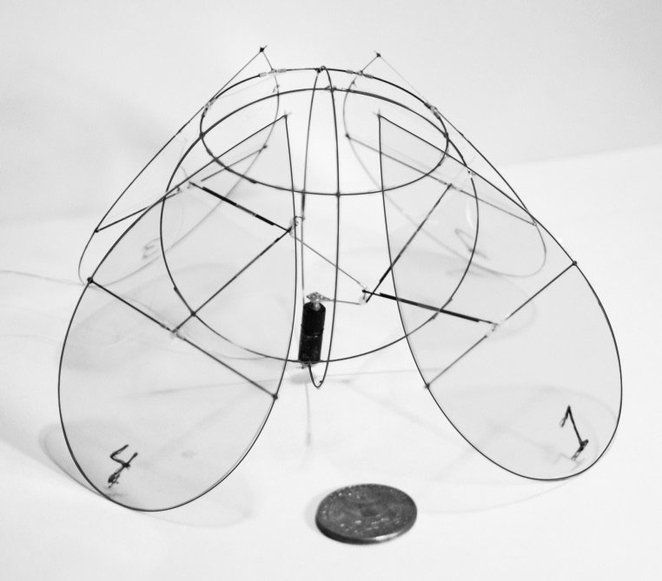A flying jellyfish-like machine
December 3, 2013

Flying jellyfish weighs just two grams and is eight centimeters wide. It flies by flapping four wings that are arranged like petals on a flower. (Credit: L. Ristroph/NYU)
New York University researchers have built a small vehicle whose flying motion resembles the movements of a jellyfish or moth — a new method of flight that could enable miniaturized future robots for surveillance, search-and-rescue, and monitoring of the atmosphere and traffic.
Many approaches to building small aerial robots try to mimic the flight of insects such as fruit flies. The problem, says Leif Ristroph of NYU, is that the flapping wing of a fly is inherently unstable.
The prototype is limited: it’s attached to an external power source and can’t steer, either autonomously or via remote control, but it shows a proof of principle, Ristroph said.
The longstanding goal for researchers has been to shrink flying robots down to the size of a centimeter, allowing them to squeeze into small spaces and fly around undetected. The simpler the better, he said. “And ours is one of the simplest, in that it just uses flapping wings.”
Abstract of American Physical Society’s Division of Fluid Dynamics meeting presentation
Ornithopters, or flapping-wing aircraft, offer an alternative to helicopters in achieving maneuverability at small scales, although stabilizing such aerial vehicles remains a key challenge. Here, we present a hovering machine that achieves self-righting flight using flapping wings alone, without relying on additional aerodynamic surfaces and without feedback control. We design, construct, and test-fly a prototype that opens and closes four wings, resembling the motions of swimming jellyfish more so than any insect or bird. Lift measurements and high-speed video of free-flight are used to inform an aerodynamic model that explains the stabilization mechanism. These results show the promise of flapping-flight strategies beyond those that directly mimic the wing motions of flying animals.